American Sabbatical 66: 3/9/97
Visionaries and Schnorrers
3/8.. Visionaries.
There are daffodils out in Maryland, clustered up against south-facing walls, and tulip trees are
blooming. Maples are beginning to burst their bud cases and the
mid-day air was balmy on Saturday.
Our wide-roving gabfest got up with us in the AM, breakfasted
on omelettes and bagels, and went for a long hike around the local
lake. Roni is a social worker and Stan directs a large social
work agency, so they have an informed view of the cultural dynamics
in their purview, and our talk turned from the battles over schools
to the aging of paradise.
American public education is a single beast, rattling the same
cage everywhere. Special Ed has gotten out of hand as a proportion
of budgetary effort, the crunch has swallowed arts and music programs,
mainstreaming and tracking are class issues, honoring self-esteem
has been corrupted into passing out pablum and applauding. We
are reminded once again how progressive Maine schools are, and
Freeport especially. Roni and Stan were surprised to hear there
are social workers in our schools. And classism is the unspoken
modality of Columbia’s schools.
Stan and Roni’ first two kids went through “the best” local schools,
which meant they were fully integrated racially, but strictly
upper-middle. Now their third, Rebekah, is in with THEM, and her
parents are delighted. But Columbia itself is increasingly upscale,
and that puts the town at odds with the rest of county, all of
which the school system serves. Roni and Stan applaud the leavening,
but agree that class is still the most divisive factor in our
polity. Must be a bunch of pinkos.
We all spent the afternoon in Baltimore enjoying the waterfront
amenities. I proposed a drive-by singalong at Fort McHenry, but
everyone shouted at me when I got to “the rockets red glare,”
and insisted I walk around the parapets as penance. It was a sparkling
warm afternoon with a Chesapeake wind snapping the flags, and
I admired the Francis Scott Key bridge silhouetting over the outer
harbor.. a lovely arched cantilever.
Then we entered the Twilight Zone. There is a new American Museum
of Visionary Art in a renovated warehouse district, and we were
drawn to it like a magnet. Where else but America can you see
scholarly texts posted alongside museum displays of junk art made
by schizophrenics? This is the ultimate comeuppance for the whole
lifted snoot school of art collecting. All the biggies are here:
Rev. Howard Finster, Saint EOM of Pasaquan.. all our favorite
outsiders. Found object fantasies, reclusive lifeworks in tin
foil, biblical concordances on driftwood, extraordinary whirligigs,
angels on glass, decorated autos.. in fact there were films of
encrusted autophilia, including a short feature following an earnest
young decorator through endless court proceedings regarding his
embellished VW bug.. hilariously tongue-in-cheek. But the audience
was as much fun as the show. Frowning visitors carefully reading
the annotations and looking confused, and youngsters in gladrags
giggling helplessly. A very youthful audience, for the most part..
we felt like the elders.. but not a poor crowd. Entrance was $6
per. As Peggy pointed out, none of the artists could have afforded
to go. Still, you have to cheer a society democratic enough to
honor its naive visionaries, and not care if its leg gets pulled.
| The museum itself was as welcoming as its assemblages were gaudy,
and the harbor views from its glasswalled upper floors are panoramic.
Although Stan and Roni say that the waterfront urban renewal never
really spread beyond its original confines, this part of Baltimore
IS very attractive, and the mix of industrial port, highrise backdrop
and graceful harborside amenities feels healthy to passing strangers. |
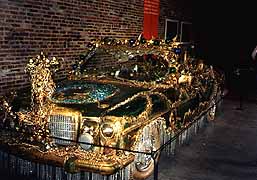
Auto Vision
|
We had promises to keep farther below the Mason-Dixon, however,
so we jacked back into the Owl in Columbia, and pointed him south.
The old Baltimore-Washington Parkway we were directed to follow
is all torn up, and we were amused to watch a bit of cultural
drama played out in the creeping cars around us. Three kids from
South Carolina in a boombox beater ahead of us got tired of the
ordinariness and started passing a joint, the girl in the middle
getting double hits. Pretty soon they were happily animated, and
the shaved-head button-downs alongside in their shiny cars began
twitching and getting red necks. The kids were just starting to
makeout a trois when the jam broke up, and the uptights spun rubber
to get away from the disgusting display. Ah America.
(Memo # 54)
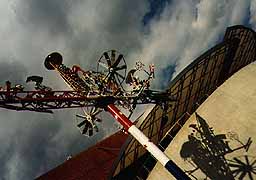
A cockeyed world
|
March 7 - American Visionary Art Museum / outsider art
Who ? self-taught, nonestablishment producers of whirligigs and
thingamajigs, with artistic vision.
What ? art that isn’t in the great museums, but is in the garages,
windowboxes, and dooryards of America.
Where? Baltimore, Maryland.
When? recently.
How? art that makes you giggle with delight.
Topics: art, visionary art, museums.
Questions: What is art? What is great art? Can you do great art
with bottlecaps and buttons? What does it mean for an artist to
be "self-taught"? |
We grow up learning to identify great art. It lives in museums
(and on posters and ashtrays and umbrellas). The names of great
artists are spoken in a different , reverent tone of voice (Michelangelo,
Leonardo, Picasso). Great art is analyzed and reviewed and hung
in galleries and bought for huge sums of money. It illustrates
history texts. When I was a teenager the Mona Lisa came to the
New York World’s Fair. I waited in line for hours, and then rode
a slowly moving sidewalk past a small greenish canvas. It seemed
strange, but thousands of people were waiting to see this piece
of great art. It was better to simply walk into the Met every
week or so and visit my favorite paintings. I would sit and look
for a while and leave with a smile. I knew it was all supposed
to be great art in the Met, but I also knew there were certain
paintings that spoke to me personally.
| I grew up and married a wood sculptor and began to know legions
of creative people who paint and sculpt and weave and sew and
draw. I began to wonder how and why certain works get chosen as
great art. For every artist I know that has a gallery show, there
are ten who create beauty for family and friends. Who would become
known as today’s great artists? How would we know? |
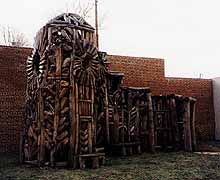
Log Art
|
Recently I learned about Sofronisba. That’s Sofronisba Anguissola
(possibly misspelled), a Renaissance woman artist. One of the
legion of artists who aren’t part of the canon of great art. How
good was she? Leonardo da Vinci said she was better than he was.
So I am less sure of what great art is now and find myself delighting
in much nontraditional art - in the work of Spindleworks in Brunswick,
in the stained glass of our friends the Jackmans, in the visions
of Wally who creates with found objects. All of these people could
be showcased at the American Visionary Art Museum in Baltimore.
It is a museum that make you giggle and guffaw.
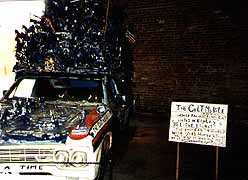
Horsepower
|
A twenty foot high structure of multiple whirligigs and wind chimes
sits in the outer courtyard of the museum. One rotating wheel
has an endless circle of coffee mugs. In a huge brick warehouse
there are the automobile visions (one with its 1,045 horsepower
illustrated by 1,045 lurid plastic toy horses mounted on the outside).
I preferred the encrusted limo with a mosaic of broken glass on
the hood, garish frogs on the mirrors, and fringe over the wheels
(this is just the barest hint of its wonderful decor - and, yes,
I have pictures).
|
Inside it got better - a bicycle made entirely of bottle caps
(even the wheels), a table holding a hundred small dolls, a huge
airplane, clotheshanger wire art, collages of found objects, surreal
paintings, a case of heads made from old paintbrushes. The absurd
and ridiculous and poignant.
| Short biographies introduced the visionaries and their often tragic
lives. Some were veterans appalled by war, some casualties of
industrial society who had lived in mental institutions and V.A.
hospitals, some were recluses and prophets, some were machinists
who created metal fantasies at home, some were mainstream folks
with whimsy. Often they died in poverty. Often their art was found
after their deaths filling sheds or trunks. Many were women, many
black, many Hispanic, many bluecollar workers, many mentally challenged.
Nontraditional artists. Self-taught. No studio art or Art Appreciation
courses. |
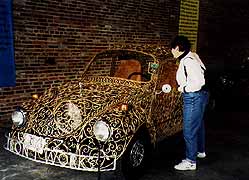
Buggy
|
So it was fun and funny and instructive. It made us laugh and
smile and itch to combine paper and glass and dried vegetation.
Was it all a huge put on? After all, there were crowds of people
peering seriously at bottlecaps and broken glass and old teapots
in this museum.. And we had all paid $6 for the privilege.
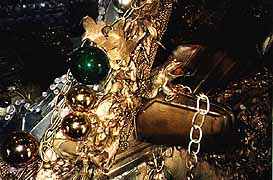
Close-up Deco
|
The museum gift shop has jewelry made of junk and Christmas decorations
of coke can tin shapes with ridiculous add ons. There are dashboard
art kits and jeweled rocks. My six year old cousin could do this.
Maybe that’s the point. Everyone has artistic visions. Maybe anyone
can make beautiful art for museums. |
3/8-9.. DC.
The great national swamp is so low-lying you are all tangled up in city traffic before
you know you’re there, kind of like an involvement in politics..
first you give a little money, then you’re sleeping in the White
House, then you are an item in the press.
We shunted into the Capitol on New York Avenue, and only caught
fragmentary sightings of the great white temples of democracy
between hotels and around buses on our way to Steve and Mary Ellin’s.
Those of you who have been taking notes will remember we visited
them in southern Vermont last August at the beginning of this
Odyssey, and now we were navigating to their home turf.
| Which is very inviting on the brink of spring. Tulip trees in
blossom on Embassy Row, flowering shrubs budding out, tinges of
pastel edging winter’s somber gray. And the pace seems gentrified
on the streets. No honking cabs, nobody acting out when you are
in the wrong lane. I suppose everyone here is from somewhere else..
like America. Was it the balmy weather that had everyone smiling,
or was CNN on strike? |
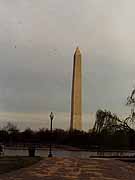
Mall of America
|
After monochrome Maine and two-tone Baltimore, the ethnic rainbow
of Washington is a visual delight. We think of this town as the
place where we send our favorite sons and daughters to get corrupted,
and imagine it full of faceless bureaucrats, talking heads, and
leering pols, but it is the crossroads of the world, and every
hue of flesh, every style of costume, every exotic gesture can
be seen on Massachusetts Avenue.
The Lerners live up behind the National Cathedral, and we found
their house to be totally unexpected. These are two New Yorkers,
born and bred, and I imagined they’d live in something like the
attached brownstone on 84th Street where Steve introduced me to
city sophistication.. or at least French cigarettes and German
beer for breakfast... in the early 60’s. But they live in a detached
old yellow house with a porch and yard that might be anywhere
in small town USA. Except that the carillon of the cathedral rings
down their tree-lined street, and the bus on the corner can take
you to the seats of power. This may be the best of both worlds:
neighborhoods with green places for a kid to play, local schools
within walking, and a major city at your feet. Ben, the Lerner’s
5-year-old, is certainly thriving on this kind of urban diet.
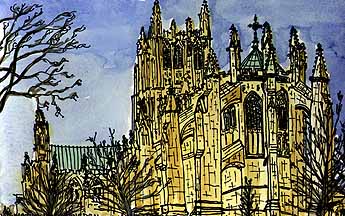
National Cathedral
Washington is a surprisingly small town, with a population of
only 800,000 in the District, which may explain some of the coziness
of politics in this burg. But you don’t want to be poor here.
The homeless are highly visible, and inevitably black. In a town
where the buildings are so elegant it must be more of an affront
to be indigent. Mary Ellin reports that they know particular homeless
characters who have staked out their public turf, and whom more
affluent locals support as their local schnorrers. She was quite
upset, though, that one oversized character was turning more hostile
and erratic, and she was having to avoid his territory, rather
than confront his behavior.
This sort of civility toward indigents is a far cry from what
the merchants’ associations have done in NYC, which is forcibly
evict them. You don’t get panhandled much in downtown New York
anymore, because they’ve been given the bum’s rush. Do Washingtonians
really treat all comers as fellow Americans?
We spent two days in the District, hardly long enough to do anything
but sip at the font. We didn’t visit any of the great collections,
because I still have a bad case of museumitis.. all that GREAT
ART buried in mausoleums makes me gasp for air. So what do you
do to get a taste of OUR city?
We walked around the neighborhood on the top of cathedral hill,
and squinted up at the heights of modern gothic architecture.
This cathedral is about half way between the encrusted edifices
of medieval Europe and the naked stylization of the Mormon temple
in San Diego, both in miles and styles. It takes the classic cathedral
form, but has a modern air in its sparse embellishment, and in
the sculptural treatment of its iconography.
Steve particularly wanted me to see the big circular carvings
which dominate the west portal. Over the central door is a swirling
stone cloud of creation, with naked couples coming into manifestation.
Steve saw this as sex at the heart of genesis, but the sculptor
has fudged on the necessary instruments, and these are (almost)
sexless males and females.. was this funded by the National Commission
for the Arts?
Inside I noticed that the bosses where the ribs meet have been
carved with allegorical images, as of old, but they are designed
to accommodate the electrical fixtures which depend from their
centers.. so the problems of rendering a biblical tale in a disc-shaped
carving to be seen from below is compounded by having to wrap
it around a circle. Here, as in the hilarious gargoyles outside,
the execution is noticeably modern. The way we distort relative
scales and features to caricature is very different from the original
gothic. Our eyes have been educated to a minimalization of detail,
and an inflation of faces and hands, and you might almost call
these carvings comic book gothic. And the carvers are still at
it. All around the cathedral are empty niches waiting for their
saints. Sort of like America.. an unfinished work.

The Wall
|
We felt at least one pilgrimage was absolutely necessary, to the
Vietnam War Memorial. It had turned raw and ominous the afternoon
we drove down to the mall, and we mistakenly parked so far away
from the site that we had a long cold hike to the bleak monument.
The way it should be, of course. 59,000 names cut into a long
black wall, which mirrors our passing. The two wings of the memorial
wall point at the Washington and Lincoln Memorials, and you descend
from those idealizations into the sober reality of all those young
names. |
Steve asked when we were going to build a memorial to those of
us who risked so much to stand up against that misadventure. But
I see the wall as both a tribute to those who died and a testimony
to a failure of policy. I hardly feel smug about my military service
in those conflicted times.
A big black guy, dressed in the same hooded sweatshirt and vest
that I wear this season, was digging in the trash baskets at the
edge of the memorial, and watching the tourists carefully. We
eye-to-eyed from 50 yards out, and I drifted his way like some
strange colleague. Clear-eyed, outdoor complexioned, he made a
cockeyed grin totally without condescension, standing quiet and
erect.
“Spare change?”
“Actually, all I have is a 10 peso piece.”
“Maybe we should all move to Mexico.”
Well spoken, the only personable interchange we had in this emotional
place, where everyone else avoids your eye.. I give him a dollar
bill.
“Thanks. Where you folks from?”
“Maine.”
“Must be cold up there.”
“Different kind of cold.”
“Yup.”
|
My schnorrer on the Mall. A vet? I didn’t ask, but he was the
right age. All the squishy tourists, the chic diplomats, the hard-eyed
security types, the scuttling bureaucrats, and this one forceful
presence on the mall.
The weeping willows draped their yellowgreen branches over the
ponds, and the family groups by the water revealed their species
prejudices by chasing away the gulls and feeding the ducks. Funny
how we choose where our charity should go. |
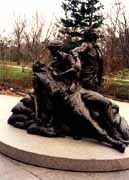
For those who need images
|
We ate dinner that night at the Japan Inn with the Lerners, and
shared a memorable meal. We’re talking embassy Japanese, with
the waitresses in modified geisha, and the decor in stylized paper-and-laquered
rectilinearity. The Japanese are superb at presentation, and we
were served in high ceremony with the ritual artifacts, without
a trace of condescension.
Eating small portions (probably large by Japanese standards) with
chopsticks sets a gracious pace, and the food was exquisite. The
hot saki may have had something to do with that, of course. I
opted for seaweed salad and eels, and we all shared sashimi with
ginger and hot sauce. O my. The tea and ginger ice cream simply
ran the last of the rack.
So.. what about seaweed and eels, I hear the Mainers ask? Well..
after I go down to the shore for a salad, I’m going to see if
Jimmy’s got any big ones in his car?









